
Oenothera lindheimeri, formerly Gaura lindheimeri, and commonly known as Lindheimer's beeblossom, white gaura, pink gaura, Lindheimer's clockweed, and Indian feather, is a species of Oenothera.

Oenothera curtiflora, known as velvetweed, velvety gaura, downy gaura, or smallflower gaura, is a species of flowering plant native to the central United States and northern Mexico, from Nebraska and Wyoming south to Durango and Nuevo Leon.
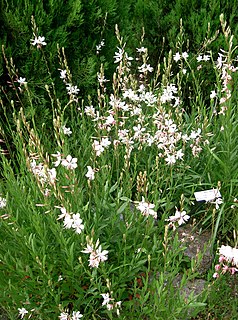
Gaura is a genus of flowering plants in the family Onagraceae, native to North America. The genus includes many species known commonly as beeblossoms. Recent genetic research has shown that the genus is paraphyletic unless the monotypic genus Stenosiphon is included within Gaura, increasing the number of species in the genus to 22.

Oenothera suffrutescens is a species of flowering plant in the evening primrose family known as scarlet beeblossom and scarlet gaura.
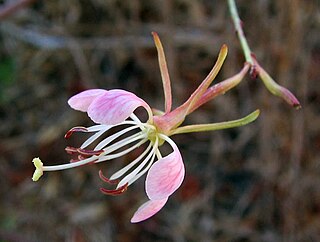
Gaura sinuata is a species of flowering plant in the evening primrose family known by the common names wavyleaf beeblossom and Red River gaura. In 2007 the species, along with the genus Gaura was reclassified in the genus Oenothera. This species then becomes O. sinuosa in Oenothera Section Gaura.

Lepidium perfoliatum is a species of flowering plant in the mustard family known by the common names clasping pepperweed and perfoliate pepperwort. It is native to Europe and Asia and it can be found in other parts of the world as an introduced species.

Oenothera californica, known by the common name California evening primrose, is a species of flowering plant in the evening primrose family.

Oenothera glazioviana is a species of flowering plant in the evening primrose family known by the common names large-flowered evening-primrose and redsepal evening primrose.

Oenothera laciniata is a species of flowering plant in the evening primrose family known by the common name cutleaf evening primrose. It is native to the eastern United States but it can be found in many other places as an introduced species and sometimes a noxious weed. It is reported from Hawaii, Australia, Britain, France, Korea, Japan, and other areas. This is an annual or short-lived perennial herb producing a spreading stem from a hairy rosette of deeply cut or lobed leaves. Flowers occur in the axils of leaves higher on the stem. Each flower has pale to deep yellow petals up to about 2 centimeters long which fade orange, pink, or red with age. The fruit is a cylindrical capsule up to 5 centimeters in length.

Oenothera longissima is a species of flowering plant in the evening primrose family known by the common name longstem evening primrose. It is native to the southwestern United States, where it grows in relatively moist areas in scrub and woodland habitat. This is a biennial herb producing a tall, erect stem known to well exceed 2 meters in height. The widely lance-shaped leaves may be 22 centimeters in length and may have slight teeth along the edges. The inflorescence is a spike of showy large flowers. Each has yellow petals which may be more than 6 centimeters in length and fade orange or red with age. The fruit is a lance-shaped capsule up to 5.5 centimeters long.

Oenothera primiveris is a species of flowering plant in the evening primrose family known by the common names yellow desert evening primrose, bottle evening-primrose, and desert evening-primrose.

Oenothera wolfii is a rare species of flowering plant in the evening primrose family known by the common name Wolf's evening primrose. It is native to the coastline of southern Oregon and northern California, where it grows in coastal prairie, dunes, and coastal forest and woodland habitat. As of 1997 it was known from only about 16 occurrences. The biggest threat to the plant is its easy hybridization with its relative and probable descendant, Oenothera glazioviana. As this rare wild plant crosses with the introduced garden escapee, introgression occurs, causing what is known as genetic pollution; fewer pure individuals of O. wolfii will be seen as they are outnumbered by hybrids.
Pyrrocoma carthamoides is a species of flowering plant in the aster family known by the common name largeflower goldenweed. It is native to western North America from British Columbia to northeastern California to Wyoming, where it is known from grassland, woodlands, forests, barren areas, and other habitat. It is a perennial herb growing from a taproot and producing one or more stems to about half a meter in maximum length, the stems reddish-green and leafy. The largest leaves are at the base of the stem, measuring up to 20 centimeters long, lance-shaped with spiny sawtoothed edges. Leaves higher on the stem are smaller and hairier. The inflorescence is a single flower head or a cluster of up to four. Each bell-shaped head is lined with phyllaries each up to 2 centimeters long. It has many yellow disc florets surrounded by a fringe of yellow ray florets up to 7 millimeters long; ray florets are occasionally absent. The fruit is an achene which may be well over a centimeter in length including its pappus.

Sisymbrium orientale is a species of flowering plant in the family Brassicaceae known by the common names Indian hedgemustard and eastern rocket. It is native to Europe, Asia, and North Africa, and it can be found throughout much of the temperate world as an introduced species and in some areas a common roadside weed. It is an annual herb producing a hairy, branching stem up to about 30 centimeters tall. The basal leaves are divided into deep lobes or toothed leaflets. Leaves higher on the stem have lance-shaped blades with small separate lobes near the base. The top of the stem is occupied by a raceme of flowers with light yellow petals each measuring up to a centimeter long. The fruit is a silique which can be up to 10 centimeters long.

Tricardia is a monotypic genus of flowering plants in the borage family containing the single species Tricardia watsonii, which is known by the common name threehearts. It is native to the southwestern United States, where it grows in deserts and mountains in sandy open habitat, often beneath shrubs. It is a perennial herb growing from a taproot and a woody caudex covered with the shreddy remains of previous seasons' herbage. It produces several erect stems up to about 40 centimeters tall. Most of the leaves are located in a basal rosette about the caudex. They are lance-shaped and coated thinly in woolly hairs. They are up to 9 centimeters long and are borne on petioles. A few smaller leaves occur higher on the stem. Flowers occur in a loose cyme at the top of the stem. Each has a calyx of five sepals. The outer three are heart-shaped and green to pink or purple in color, and the inner two are much smaller and narrower. The flower within is bell-shaped, white with central purple markings, and roughly half a centimeter wide. The fruit is a capsule just under a centimeter long which contains 4 to 8 seeds.
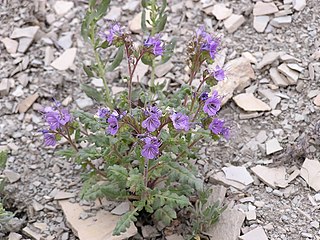
Phacelia argillacea is a rare species of flowering plant in the borage family known by the common names clay phacelia and Atwood's phacelia. It is endemic to Utah in the United States, where it is known only from one canyon in Utah County. It is "one of Utah's most endangered species"; it is "one of the nation's rarest plants" and is federally listed as an endangered species of the United States.
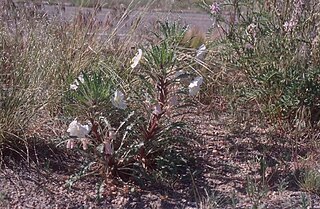
Oenothera harringtonii is a species of flowering plant in the evening primrose family known by the common names Arkansas Valley evening primrose and Colorado Springs evening primrose. It is endemic to the state of Colorado in the United States.
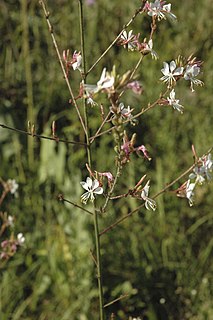
Oenothera guara, formerly known as Gaura biennis, the biennial gaura or biennial beeblossom, is a North American flowering plant that can reach 6 ft (1.8 m) in height at maturity. Its upper half is made up of flowering stems, which are covered with soft, white hairs. It has light pink colored flowers, which turn a vibrant red/pink color in the late summer to early fall seasons. These colors make this plant attractive to butterflies and bees, and are in full bloom just before many fall plant species begin to bloom.

Oenothera suffulta, known as roadside gaura, honeysuckle gaura, or kisses, is a flowering plant in the primrose family, Onagraceae. It is endemic to the United States, in Texas and southern Oklahoma.

















